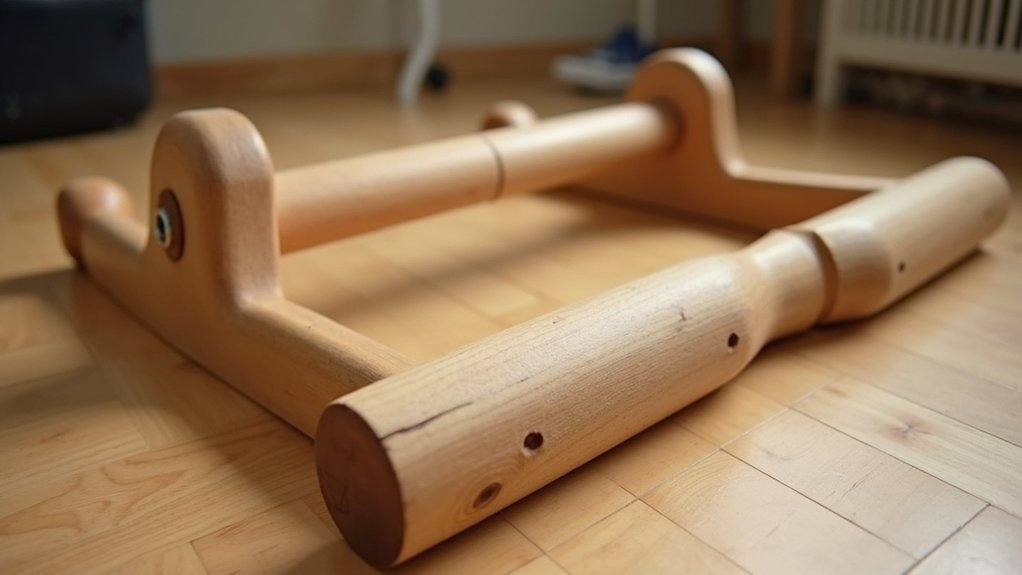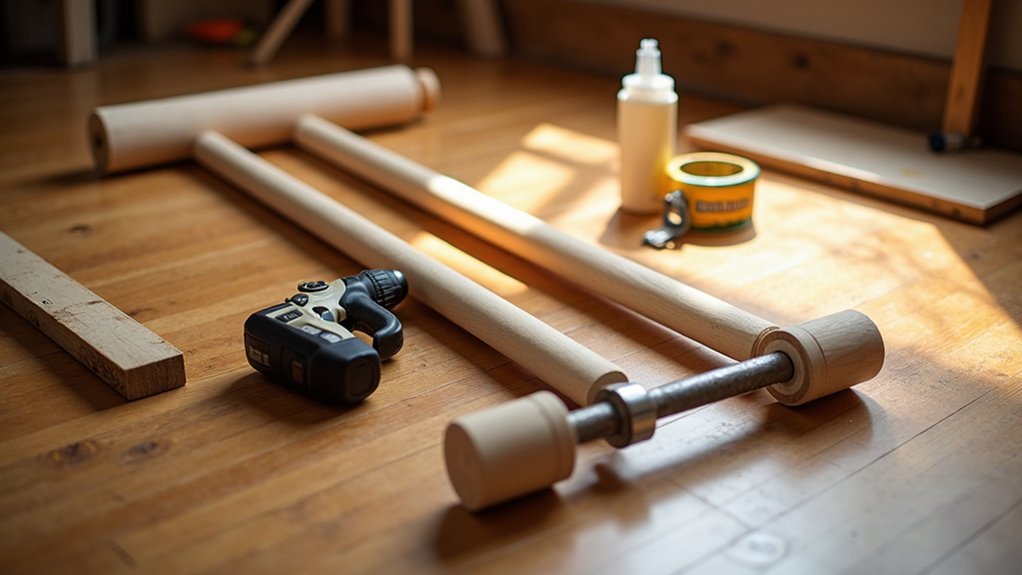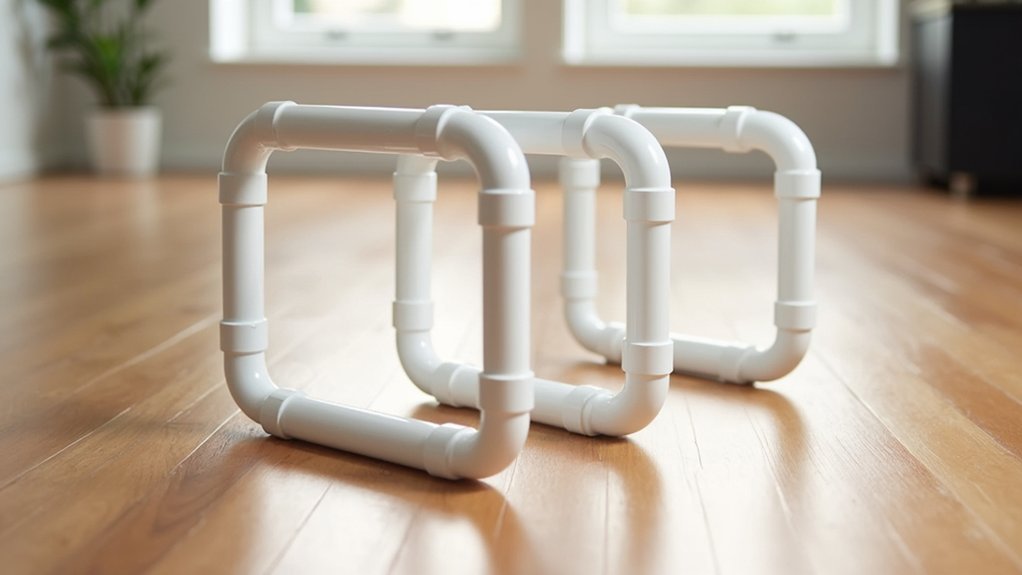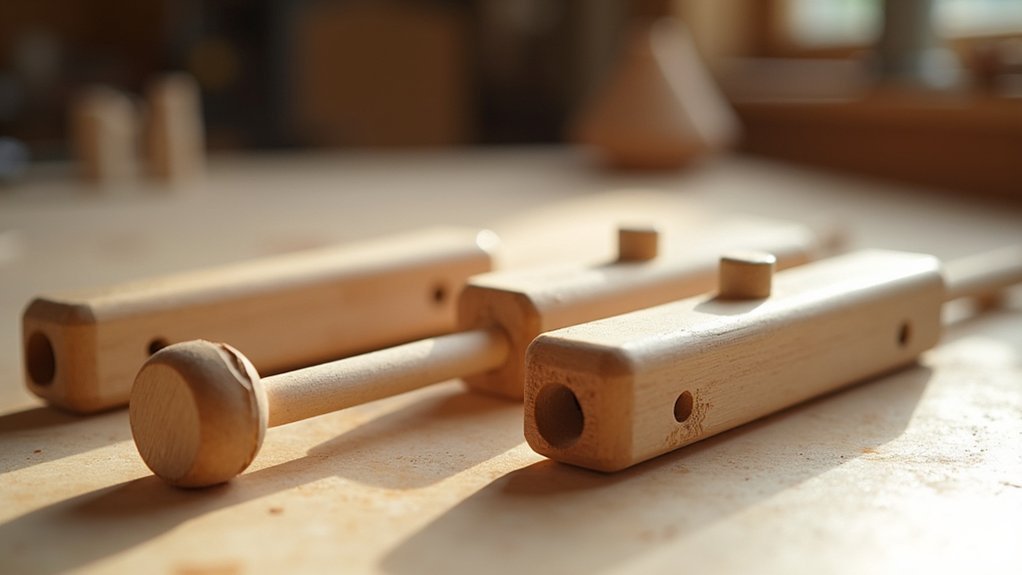Just as gymnasts rely on precision equipment to master their craft, you’ll soon discover the transformative power of parallette bars for core training. These compact, versatile platforms aren’t just another fitness gadget—they’re a strategic tool for developing core strength and stability. If you’ve been searching for a cost-effective way to elevate your home workout routine, building your own parallette bars might be the game-changing solution you’ve overlooked. Curious about how a simple set of bars can revolutionize your fitness approach?
Key Takeaways
- Create DIY parallettes using 1.25-inch PVC pipes, T-joints, elbow joints, and caps to develop an affordable home core training tool.
- Design parallettes with adjustable height and width to accommodate different seated core exercises like L-sits, leg lifts, and balance challenges.
- Enhance core stability by utilizing parallette bars for support during seated positions, progressively increasing exercise difficulty while maintaining proper form.
- Select exercises ranging from beginner to advanced levels, focusing on controlled movements that engage abdominal muscles and improve overall core strength.
- Incorporate isometric holds and dynamic movements on parallettes to build muscular endurance, track progress, and systematically develop core muscle groups.
What Are Parallettes and Why Build Your Own?

Leverage your home workout potential with parallettes—compact, versatile training tools designed to revolutionize bodyweight strength conditioning. These small, elevated bars simulate traditional parallel bars, enabling dynamic exercises that target core and upper body muscle groups with precision.
By constructing your own parallettes, you’ll transform a $20-30 investment into a powerful fitness asset. The DIY approach not only reduces expenses compared to professional models costing thousands but also empowers you with customization options. You can adjust height and width to match your specific fitness level and training objectives.
The construction process involves straightforward PVC materials like pipes, T-joints, and elbow caps, making it accessible even for individuals with minimal technical skills. Your self-built parallettes become more than equipment—they’re a reflection of your commitment and ingenuity in fitness.
Materials and Tools You’ll Need

Crafting robust DIY parallettes demands precision in material selection and tool procurement. You’ll need approximately 12 feet of 1.25-inch diameter PVC pipe, which serves as the primary structural component. Essential procurement includes 4 T-joints, 4 elbow joints, and 8 caps, typically costing $20-30. Your toolkit must encompass a PVC cutter or hacksaw for precise pipe sectioning, complemented by a tape measure and marker for accurate length determination.
Recommended supplementary materials include PVC solvent and cement for secure joint bonding, adding approximately $8 to your project cost. Consider utilizing schedule 80 PVC for enhanced structural integrity. During assembly, protect your workspace with an old newspaper or drop cloth. Systematic preparation and meticulous tool selection are vital for constructing durable, functional parallette bars that will support your core workout regimen.
PVC Parallette Construction Guide

While precise measurements are critical, constructing PVC parallette bars requires methodical preparation and strategic assembly. Begin by dry fitting all PVC components before permanent attachment, ensuring precise alignment of T-joints, elbow joints, and pipe segments. Use a PVC cutter or hacksaw to achieve clean, accurate cuts that guarantee structural integrity.
When ready to permanently connect pieces, apply PVC solvent and cement carefully, allowing each joint to set completely. Pay special attention to the 90-degree elbow orientations, which greatly impact the bar’s stability and weight-bearing capacity. The entire construction process can be completed within 30 minutes, resulting in a robust training tool capable of supporting over 200 pounds.
Consider optional customizations like adding grip tape or paint to enhance both functionality and aesthetic appeal of your DIY parallettes.
Wooden Parallette Building Steps

After mastering PVC parallette construction, woodworking enthusiasts can explore a more robust alternative: wooden parallette bars. Begin by gathering your materials: 1.5-inch wooden dowels, 2×6 wooden planks, copper pipe, and necessary fittings. Carefully measure and cut the dowels and planks to create a stable pair of parallettes. Use a saw to achieve precise lengths, ensuring symmetry between both bars.
Drill strategic mounting points to secure the dowels to the wooden base, focusing on structural integrity. Select appropriate copper pipe fittings to reinforce connections and enhance durability. The construction requires basic woodworking skills and tools, so approach the project methodically. While more complex than PVC alternatives, wooden parallettes offer superior strength and an aesthetically pleasing finish for your core workout equipment.
Pre-Made Parallette Options

For fitness enthusiasts seeking a hassle-free parallette solution, pre-made options from specialized manufacturers offer a compelling alternative to DIY construction. Companies like Core Strength Company provide high-quality parallettes that eliminate complex building processes.
| Feature | Cost | Assembly |
|---|---|---|
| Durability | $150+ | Minimal |
| Stability | High | Easy |
| Weight Capacity | Tested | Quick |
| Design | Professional | Included Tools |
These pre-made parallette options deliver immediate functionality with professional-grade construction. You’ll save significant time and effort, receiving a product engineered for performance and aesthetic appeal. The investment guarantees reliable equipment tested to support substantial weight without compromising structural integrity. Unlike DIY alternatives, these parallettes come precision-manufactured, requiring minimal assembly and providing an instant, professional-quality addition to your home gym setup. With quick setup and assured quality, pre-made parallettes represent a smart choice for serious fitness practitioners seeking efficient, reliable training equipment.
Essential Exercises for Parallette Training
Having explored pre-made parallette options, fitness enthusiasts can now focus on maximizing their training potential through targeted exercises. A pair of parallettes offers versatile opportunities for advanced core conditioning. L-sits challenge your abdominal muscles and hip flexors while developing remarkable body control. Seated pike holds enhance core strength and simultaneously improve lower back and hamstring flexibility. Elevated seated leg lifts systematically engage core stabilizers, promoting balance and thorough abdominal activation. Dynamic movements like tuck-ups generate intense core endurance through controlled, repetitive muscle contractions. These exercises leverage parallettes’ compact design, supporting precise alignment and technique. By integrating these strategic movements, you’ll transform your core training, developing strength, stability, and muscular endurance with minimal equipment and maximum efficiency.
Safety Tips and Maintenance
While parallette bars provide exceptional strength training opportunities, prioritizing safety and consistent maintenance remains essential for preventing potential injuries and equipment degradation. Carefully inspect your DIY parallettes before each workout, checking for structural integrity, secure joints, and material soundness. When setting up your training area, always place a non-slip surface underneath to minimize potential slipping risks during dynamic movements.
Your safety tips should include routine examinations for wear, such as identifying cracks in PVC or wood splinters that could compromise equipment stability. If customizing parallettes with paint or grip tape, select non-toxic, durable materials designed to withstand consistent physical stress. Store your parallettes in a dry environment to prevent moisture-related deterioration, ensuring long-term reliability and performance during seated core and strength training exercises.
Progressing Your Parallette Workout Routine
After mastering safety protocols and maintaining your DIY parallettes, athletes can strategically advance their strength training through progressive bodyweight techniques. Focus on systematic core development using parallel bars with this targeted approach:
- Begin with foundational exercises like L-sits and seated leg lifts
- Incrementally increase hold durations from 10-15 to 30-60 seconds
- Integrate dynamic movements such as knee tucks and tuck-ups
- Advance to challenging variations like straddle L-sits and planche leans
- Schedule consistent 2-3 weekly training sessions with adequate recovery periods
Progression demands methodical skill building, where each exercise builds upon the previous movement’s strength and control. By carefully selecting exercises and managing intensity, you’ll develop enhanced core stability, muscular endurance, and thorough upper body strength through strategic parallette training.
Frequently Asked Questions
What Size Dowel for Parallettes?
You’ll want a 1.5-inch diameter hardwood dowel for ideal parallette performance. This thickness provides superior grip, reduces wrist strain, and guarantees durability during challenging bodyweight exercises. Choose a robust dowel that’ll support your strength training effectively.
Are Push-Up Bars and Parallettes the Same?
Buckle up for a fitness revelation! Push-up bars and parallettes aren’t identical twins. Bar differences include height, stability, and exercise versatility. While both elevate your workout, parallettes offer broader movement potential for advanced bodyweight training techniques.
How Do You Do Parallette Bars?
You’ll master parallette techniques by starting with L-sits, dips, and push-ups. Maintain proper hand placement, engage your core, and progress systematically. Focus on controlled movements, gradually increasing difficulty while ensuring stable bar positioning and precise body alignment.
How Do You Make Parallettes?
Precisely pick PVC pipes and purposeful parts. You’ll need 12 feet of 1.25-inch pipe, T-joints, elbows, and caps. Measure, cut, and connect systematically with solvent cement, creating sturdy, customizable parallettes for effective core training.
Conclusion
Your DIY parallette bars are now complete, transforming your fitness space. Remember, “Rome wasn’t built in a day,” and neither is core strength. By constructing these versatile training tools, you’ve invested in a robust home workout solution. Consistent practice and gradual progression will yield significant improvements in stability, strength, and muscular endurance. Maintain your parallettes, explore advanced exercises, and watch your fitness potential expand with each strategic training session.





